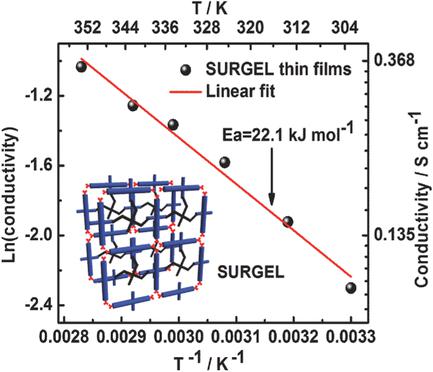当前位置:
X-MOL 学术
›
Macromol. Rapid Commun.
›
论文详情
Our official English website, www.x-mol.net, welcomes your feedback! (Note: you will need to create a separate account there.)
Water‐Stable Nanoporous Polymer Films with Excellent Proton Conductivity
Macromolecular Rapid Communications ( IF 4.6 ) Pub Date : 2017-12-18 , DOI: 10.1002/marc.201700676 Zhengbang Wang 1, 2 , Cong Liang 3, 4 , Haolin Tang 3 , Sylvain Grosjean 5 , Artak Shahnas 1 , Joerg Lahann 1 , Stefan Bräse 5 , Christof Wöll 1
Macromolecular Rapid Communications ( IF 4.6 ) Pub Date : 2017-12-18 , DOI: 10.1002/marc.201700676 Zhengbang Wang 1, 2 , Cong Liang 3, 4 , Haolin Tang 3 , Sylvain Grosjean 5 , Artak Shahnas 1 , Joerg Lahann 1 , Stefan Bräse 5 , Christof Wöll 1
Affiliation

|
Achieving high values for proton conductivity in a material critically depends on providing hopping sites arranged in a regular fashion. Record values reported for regular, molecular crystals cannot yet be reached by technologically relevant systems, and the best values measured for polymer membranes suited for integration into devices are almost two orders of magnitude lower. Here, an alternative polymer membrane synthesis strategy based on the chemical modification of surface‐mounted, monolithic, crystalline metal–organic framework thin films is demonstrated. Due to chemical crosslinking and subsequent removal of metal ions, these surface‐mounted gels (SURGELs) are found to exhibit high proton conductivity (0.1 S cm−1 at 30 °C and 100% RH (relative humidity). These record values are attributed to the highly ordered polymer network structure containing regularly spaced carboxylic acid side groups. These covalently bound organic frameworks outperform conventional, ion‐conductive polymers with regard to ion conductivity and water stability. Pronounced water‐induced swelling, which causes severe mechanical instabilities in commercial membranes, is not observed.
中文翻译:

具有优异质子传导性的耐水纳米多孔聚合物膜
在材料中实现高质子电导率值关键取决于提供以规则方式排列的跳跃点。技术上相关的系统尚无法达到常规分子晶体的记录值,适用于集成到设备中的聚合物膜的最佳测量值要低两个数量级。在此,展示了一种基于表面修饰的整体式结晶金属-有机骨架薄膜的化学修饰的替代聚合物膜合成策略。由于化学交联和随后的金属离子去除,这些表面安装的凝胶(SURGEL)被发现具有高质子传导性(0.1 S cm -1在30°C和100%RH(相对湿度)下。这些记录值归因于包含规则间隔的羧酸侧基的高度有序的聚合物网络结构。这些共价键合的有机骨架在离子电导率和水稳定性方面优于传统的离子导电聚合物。没有观察到明显的水诱导溶胀,该溶胀导致商业膜严重的机械不稳定性。
更新日期:2017-12-18
中文翻译:

具有优异质子传导性的耐水纳米多孔聚合物膜
在材料中实现高质子电导率值关键取决于提供以规则方式排列的跳跃点。技术上相关的系统尚无法达到常规分子晶体的记录值,适用于集成到设备中的聚合物膜的最佳测量值要低两个数量级。在此,展示了一种基于表面修饰的整体式结晶金属-有机骨架薄膜的化学修饰的替代聚合物膜合成策略。由于化学交联和随后的金属离子去除,这些表面安装的凝胶(SURGEL)被发现具有高质子传导性(0.1 S cm -1在30°C和100%RH(相对湿度)下。这些记录值归因于包含规则间隔的羧酸侧基的高度有序的聚合物网络结构。这些共价键合的有机骨架在离子电导率和水稳定性方面优于传统的离子导电聚合物。没有观察到明显的水诱导溶胀,该溶胀导致商业膜严重的机械不稳定性。



























 京公网安备 11010802027423号
京公网安备 11010802027423号